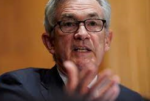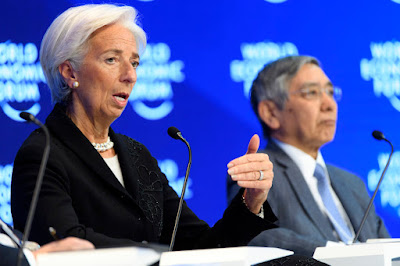The recent themes in the foreign exchange market continued last week. On the one hand, the dollar-bloc currencies and Norwegian krona trended higher, while the euro, and especially the yen, traded heavier. On the other hand, although some critics argued that the Fed's 25 bp rate hike earlier this month was too timid, the Fed is signaling it could accelerate the pace. The interest rate adjustment continued in dramatic fashion. The Fed funds futures imply almost a 77% chance of a 50 bp move at the next meeting (May 4). The general resilience of the US economy, the tight labor market (with weekly initial jobless claims falling to new lows since the late 1960s) and upticks in the flash PMI may embolden the Federal Reserve. The two-year note yield has risen by 50 bp
Topics:
Marc Chandler considers the following as important: 4) FX Trends, 4.) Marc to Market, Featured, newsletter, USD
This could be interesting, too:
Nachrichten Ticker - www.finanzen.ch writes Krypto-Ausblick 2025: Stehen Bitcoin, Ethereum & Co. vor einem Boom oder Einbruch?
Connor O'Keeffe writes The Establishment’s “Principles” Are Fake
Per Bylund writes Bitcoiners’ Guide to Austrian Economics
Ron Paul writes What Are We Doing in Syria?
The recent themes in the foreign exchange market continued last week. On the one hand, the dollar-bloc currencies and Norwegian krona trended higher, while the euro, and especially the yen, traded heavier. On the other hand, although some critics argued that the Fed's 25 bp rate hike earlier this month was too timid, the Fed is signaling it could accelerate the pace. The interest rate adjustment continued in dramatic fashion.
The Fed funds futures imply almost a 77% chance of a 50 bp move at the next meeting (May 4). The general resilience of the US economy, the tight labor market (with weekly initial jobless claims falling to new lows since the late 1960s) and upticks in the flash PMI may embolden the Federal Reserve. The two-year note yield has risen by 50 bp since Russia invaded Ukraine, and it is not done. The consensus that appears to be developing at the Fed favors a march toward neutrality, seen in 2.25%-2.50% by the vast majority of Fed officials. The two-year note yield is near 2.2%, up from a little less than 0.75% at the end of last year. More than half of the Fed officials and economists think the target rate will have to rise above neutral to counter the inflationary pressures.
A few trends in the foreign exchange market are worth noting. First the yen's weakness. The dollar has risen in 13 of the past 15 sessions against the yen. The rise in US yields and the lack of official resistance appear to have spurred and sustained the move. BOJ's Kuroda was still finding good things to say about the yen's slide ahead of the weekend. Second, the dollar bloc is on fire. The Canadian dollar has strengthened for nine consecutive sessions and 13 of the past 14. Rising commodity prices, the reduction of the US premium at the short-end, and the policy mix, following the Liberal-NDP pace, lend support to the Canadian dollar. The S&P 500 has advanced in seven of the past nine sessions, and this proxy for risk appetites underpinned the Loonie. The Australian dollar has rallied in 10 of the past 13 sessions. Its 3.5% appreciation this month leads the majors. The New Zealand dollar's advance may not be as impressive, but its 2.8% gain against the greenback puts it in second place this month.
Third, Latam currencies continue to shine among the emerging market currencies. High yields, commodity exposure, and the ebbing public health crisis appear to be the main drivers. Contrary to conventional wisdom that seems to believe "everyone" wants weaker exchange rates, currency appreciation is desired throughout the region with price pressures and tighter monetary policy.
Let's drill down.
Dollar Index: Ahead of the weekend, the Dollar Index successfully tested the 20-day moving average. (~98.40). It has not closed by this moving average since February 22. Still, the high for the move was recorded on March 7 (~99.42), and despite the widening market moving to fully discount 200 bp more of Fed tightening this year, the upside momentum has stalled. The near-term barrier is the downtrend line of this month's highs at the start of the new week, around 99.00. The consolidation pattern is seen to signal the continuation of the trend, which is higher. The MACD and Slow Stochastic have drifted lower but are in the middle of the range. The Slow Stochastic may be trying to turn higher. The Dollar Index peaked in March 2020 near 103.00. However, a break of the 97.70 area would weaken the technical tone.
Euro: The euro spent the past four sessions in a $1.0960-$1.1040 range. The MACD and Slow Stochastic are trending higher, but the latter has flattened out and could turn lower in the coming days. The flash March PMI showed economic activity more resilient than economists expected. Still, sentiment surveys have weakened materially. The US-German two-year interest rate spread has widened sharply in the US favor (from about 137 bp at the end of last year to above 240 bp at the end of last week. However, it is not just the US side of the equation that is moving. Since the end of last month, Germany's 2-year yield has risen from almost -80 bp on March 7 to around -15 ahead of the weekend, a new seven-year high. If there was a genuine ceasefire, the euro would likely to recover. The swaps markets anticipate about 45 bp of tightening before the end of this year.
Japanese Yen: The three-week dollar rally against the yen has stretched momentum indicators and frayed the upper Bollinger Band, which begins next week near JPY122.60. Correlations of the change in the exchange rate and change in US yields are stronger with 10-year rates than the two-year. In the past, US industry (and officials) has often protested against yen weakness, but this time, radio silence. The OECD's measure of Purchasing Power Parity put fair value near JPY96, which makes the yen more than 26% under-valued, second only to the euro's 32% undershoot. With BOJ Governor Kuroda still embracing the benefits of the weak yen, and US rates still trending higher, there is little compelling reason to pick a top in the dollar. The JPY123.75 area may offer resistance, but the next important target is the JPY125.00-JPY125.85 area, where it peaked in 2015. Then Kuroda suggested he did not want to see a move above JPY125.00.
British Pound: Sterling is frustrating. On March 18, it tested a neckline (~$1.32) of a bottoming pattern projected toward $1.34. However, after reaching nearly $1.33 in the middle of the last week, it slipped back to almost $1.3150. The market seemed to judge the Spring budget as milquetoast, and the unexpected drop in February retail sales reported before the weekend was disappointing. That said, the momentum indicators are pointing higher, and the five-day moving average crossed above the 20-day moving average for the first time since late February. The $1.3150 area corresponds to the (50%) retracement of sterling's bounce from the test on $1.3000 on March 14 to the recent high by $1.3300. The next retracement (61.8%) is near $1.3115. The market-perceived odds of a 50 bp hike at the next meeting in May rose to almost 40% by the end of last week from about 26% the prior week.
Canadian Dollar: The Bank of Canada meets next on April 13. The swaps market now prices roughly an 85% chance of a 50 bp move, up from a 55% chance the previous week. Stronger than expected January retail sales (3.2% instead of 2.4% as the median forecast in Bloomberg's survey had it) may have played a role. Still, the Liberal-NDP tie-up means more fiscal support was also important. The central bank has suggested that the economy will be operating near full capacity around midyear. The nine-day slide in the greenback saw it fall through the six-month trendline drawn off lows from last October, January, and earlier in March (~CAD1.2565) to test CAD1.25 before the weekend. As one would expect after such a sustained move, the momentum indicators are stretched, and the Slow Stochastic could turn higher. The lower Bollinger Band begins the new week near CAD1.2475. This year's low, set in January, was around CAD1.2450.
Australian Dollar: The Australian dollar fell by about 5.6% last year, and here in Q1, it has rallied 4% to lead the major currencies. The Aussie's strength has materialized even as the two-year rate differential moved sharply against it. Its discount to the US more than doubled here in March to almost 70 bp. The futures market has pulled the first hike into June from July. The Aussie set a new five-month high ahead of the weekend near $0.7535, which meets the (61.8%) retracement objective of the slide since the $0.8000 was tested last May. The high from last October was closer to $0.7555, where the upper Bollinger Band is found. The momentum indicators are stretched. Initial support is seen around $0.7450.
Mexican Peso: AMLO's policies have not been to the liking of investors. Fiscal policy has not been engaged though around 45% of the population lives below poverty. Still, the peso has appreciated for the past 11 sessions and is at its best level in six months. It is the longest streak in half a century. The greenback took out the MXN20.00 level before the weekend and after the central bank delivered the third consecutive 50 bp hike. The next important technical area is MXN19.50-MXN19.60. By revising higher its inflation forecast, Banxico seemed to signal it intends to hike again. The swaps market has about 120 bp of tightening discounted over the next six months. The move has stretched the momentum indicators, and the lower Bollinger Band is found near MXN19.9060. The MXN20.00-MXN20.05 area that had been support may now serve as resistance. The Brazilian real surge continued. It rose by around 5.6% last week to bring this month's advance to a stunning 8.3%. The central bank signaled its intention to hike by another 100 bp in May when it meets again to finish the aggressive cycle. The market seems less convinced and has another 50 bp hike.
Chinese Yuan: The dollar rose against the yuan for the fourth consecutive week, its longest streak since last July. Over the four weeks, the greenback has risen slightly less than 0.8%. Even though the PBOC's daily dollar fix is not always stronger than the market projections, it still seems clear that Beijing would prefer a somewhat weaker yuan given the divergence of monetary policy and the recognized need for more stimulus. China's 10-year premium over the US continues to shrink. It halved last week to about 32 bp. It has been a dozen years since the US offered a premium over China, but that is where it appears to be headed. Next week's PMI readings will likely reflect an economy that is struggling. Higher commodity prices, the Covid-related lockdowns, and the loss of the property market as an engine are taking a toll. The dollar's high this month was set on March 15 next CNY6.3860. It is also the year's high. The next important chart point is CNY6.40. Dollar support is seen in the CNY6.3500-CNY6.3550 area.
Tags: #USD,Featured,newsletter







